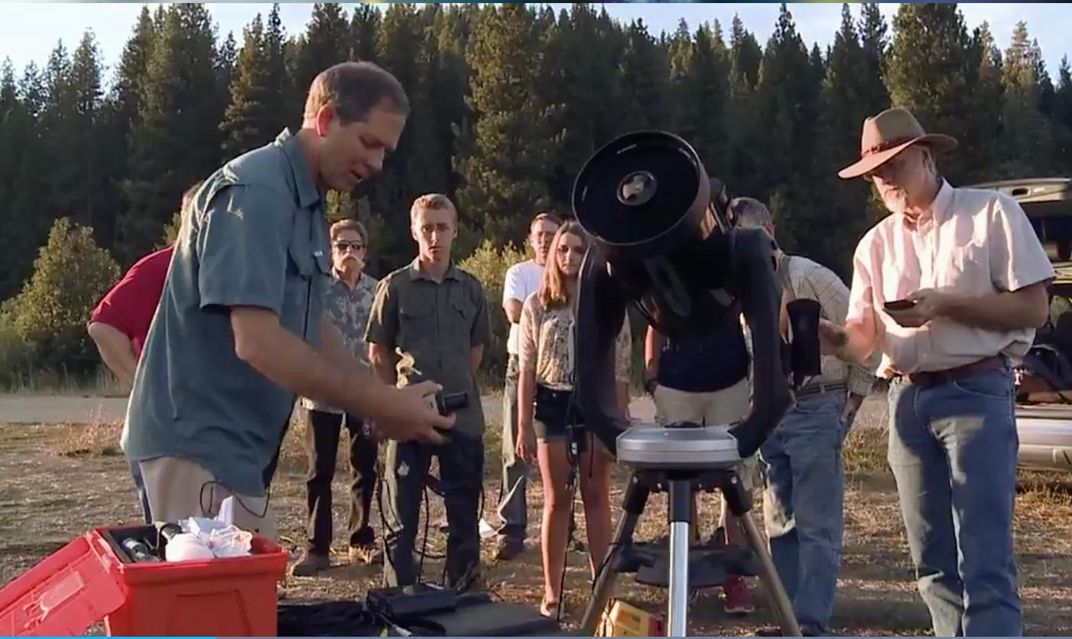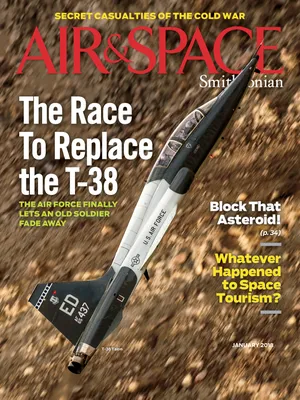Planetoid Detectives
Students and amateur astronomers help the pros track some of the most distant objects in the solar system
/https://tf-cmsv2-smithsonianmag-media.s3.amazonaws.com/filer/73/53/7353afba-4c0c-4a21-83ed-27d26699a811/01f_dj2018_nasa-kuiperbeltobject-artistsconcept-20141015_live.jpg)
Some people in the aerospace business like engineering. Others prefer science. Jeralyn Gibbs, who will graduate from the California Polytechnic State University this December with a bachelor’s degree in physics, wants to do both. Actually, she’s already done both. She spent the last three summers as an intern at SpaceX, where she participated in an investigation following a launch explosion. “Some people told me I was one of the few people who benefited [from the failure], because I learned so much,” she says.
During the school year, Gibbs works on a science project: studying some of the smallest, farthest, least known objects in the solar system. This one is a collaboration between professional astronomers and high school and college students, started by two scientists, Marc Buie of the Southwest Research Institute and John Keller of Cal Poly. Buie studies trans-Neptunian Objects (TNOs) orbiting out past Pluto, and Keller’s expertise is astronomy education. They had met at a grad school reunion in 2010, where Buie explained that he needed help on a new project. He was looking for amateur astronomers, preferably high school and college students, in communities located along a rough north-south line in the western United States, where astronomers are most likely to get clear, dry nights for observing. The network he envisioned, with a few dozen telescopes, would have a single, specialized job: watching for the brief disappearance of a star when one of these mysterious TNOs passes in front of it and blocks its light.
Such occultations may last only a few seconds, but astronomers can learn a lot from them. Analyzing how the starlight blinks off and on again can reveal the size of a TNO, and whether it has a moon or even rings. You don’t need an especially large telescope—amateurs observe asteroid occultations all the time—but you do need ultra-precise timing equipment. And TNOs are trickier than asteroids. Their positions (and therefore the precise locations on the ground from which their star crossings will be visible) generally aren’t very well known. Hence Buie’s idea of a long line of observers, all watching at the same time, so that at least a couple of them might be in the right spot to record a predicted occultation. Keller likens it to a “picket fence of telescopes, two thousand kilometers long, and spaced every fifty kilometers.”
With National Science Foundation funding, Buie and Keller consulted Google Maps to identify towns along their fenceline, sent out emails, and went on a road trip to recruit student observers. The “John and Marc show,” as Keller calls it, enlisted high school science teachers, community college astronomy professors, and students across five western states. Today, their RECON (Research and Education Collaborative Occultation Network) is at more than full strength, with some 60 teams observing in Arizona, Nevada, California, Oregon, and Washington.

As an undergraduate assistant for the RECON program at Cal Poly, Gibbs helps to set up the equipment needed for a TNO (or any) occultation, then stays with it through the event, working with the rest of the team to make sure the data is recorded properly. The setup includes an 11-inch telescope to which a GPS receiver, timer, and video recorder are attached, all to record the occultation in a standardized format.
Jessica Kisner, who’s in her junior year at Central Washington University double-majoring in physics and math (with a minor in astronomy), is on another of the RECON teams. She remembers having backyard telescopes “probably from about the age I could walk.” (Her father was into “science fiction and nerdy stuff.”) She’s comfortable using the equipment necessary for RECON observations, which the NSF grant helped to buy. But she’s also learned that “nothing ever goes as planned.” When a piece of equipment doesn’t work as advertised, or the telescope doesn’t align the way it’s supposed to, she used to get rattled. Now, RECON veteran that she is, she knows the team will find a solution.
All the RECON teams get to practice their skills with asteroid occultations, which happen more frequently, and are usually easier to predict in timing and location. For these, the groups tend to be bigger and more diverse, which lets Kisner and other veterans help younger students learn about astronomy.
The TNO observations are another story. The teams know that they may be the only ones to record an event. And the occultations happen only a few times a year. Asked if that adds stress, Kisner laughs and says, “Yup!”
“The timing aspect is actually a big problem,” she explains. “You have to make sure you got the recording, and it’s almost down to the wire every single time. It definitely does put some pressure on.”
The payoff is that they might contribute some brand-new bit of astronomical knowledge, something amateurs rarely get to do. So far the Central Washington team has yet to catch a TNO occultation, although they have successfully recorded data each time. And as CWU physics professor Bruce Palmquist says, in this case “misses are important as well.” For example, if one site records an occultation but teams on each side do not, those misses reveal a limit on the object’s size: It is smaller than the distance between the sites recording misses.
He sees RECON as “sort of citizen science, and sort of professional science. It kind of bridges the gap” in the levels of skill required. Kisner, the future teacher, says, “It shows that you don’t have to be the genius in your class, or a whiz with the telescope. You can just jump in, and after a couple of times, you’re part of the team.”
Interested in joining one of these observing campaigns but don’t live near the RECON network? Try the International Occultation Timing Association (occultations.org), which lists occultation opportunities and offers advice on what equipment to use, as well as where to send your data. Or look for another astronomy-related citizen science project at zooniverse.org, including one to help scientists find new planets in the outer solar system (backyardworlds.org).
